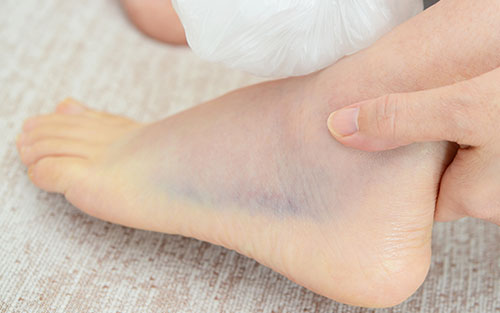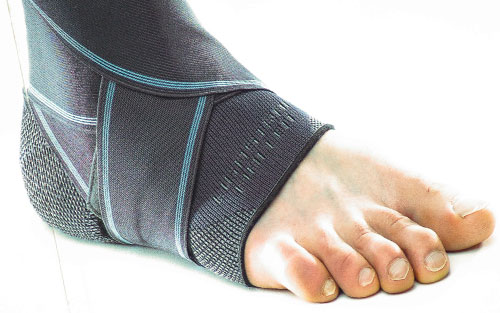Prevent prolonged pain and suffering from your sprained ankle. By understanding how your sprained ankle needs to heal, you can be walking again in no time.

yourfootpalace.com gathered information on when you can walk on a sprained ankle, what a sprained ankle is, how to treat it, and when to seek medical attention.
Can You Walk on a Sprained Ankle
No. This is not an injury that you can “walk off.” After spraining your ankle, it will need time to recover before putting any weight on it. Trying to force a speedy recovery by walking, running, or working out too soon may further aggravate the damage done to your ankle in the first place.
The bones, muscles, and ligaments comprising the foot and ankle are significantly stronger and more reinforced than those in other parts of the body. When they are injured, a significant period of immobility may be required to fully recover.
As your ankle recovers from such an injury, weight can gradually be applied to it. Initially, walking should be aided by a support system like a cane or crutches.
Sprained Ankle Treatment
After sustaining a sprained ankle, your first objective is to decrease the pain and discomfort while protecting the ankle’s ligaments from further injury. Adopting the classic R.I.C.E. regimen of treatment for the first 24 to 48 hours can help:
Rest – Rest your ankle as much as possible.
Ice – Apply ice packs or submerge your foot and ankle in cold water.
Compression – Use an elastic ankle sleeve or an elasticized wrap to help reduce swelling.
Elevation – Elevate your ankle to the height of your hip when in a seated position.

Watch this video to see the RICE method for injuries.
Tip: Avoid hot showers, heat rubs, or hot packs, as this may increase swelling and prolong your recovery time.
Generally, within 72 hours, you can begin stretching and range-of-motion exercises. You should continue these exercises until your ankle has recovered to the point of pre-injury conditions.
Watch this video to see stretching and range-of-motion exercises.
Tip: A series of reflexology massages may significantly accelerate your recovery from a sprained ankle.
Note: Remaining immobile for extended periods without initiating some sort of exercise or rehabilitation regimen can lead to further complications or delays in your recovery.
How Long Does a Sprained Ankle Stay Swollen
Two weeks to six months. However, recovery time for a sprained ankle will vary from case to case, requiring different care and recovery approaches. This recovery time can change a lot based on:
- Your fitness level
- Your age
- How bad (grade) the sprain is
- How the sprain occurred
- How much time passed before seeking treatment
As an example, recovery time for a grade one sprain is two weeks to a month. A grade two sprain can take from six to eight weeks. Finally, a grade three sprain may take anywhere from three to six months for recovery.
Note: After a sprained ankle heals, symptoms of arthritis and/or plantar fasciitis may occur. If these symptoms arise, seek medical attention to diagnose and treat these conditions.
Read more about relieving plantar fasciitis at yourfootpalace.com/how-foot-massage-can-relieve-your-plantar-fasciitis-pain/
What is a Sprained ankle
The injury known as a sprained ankle occurs when you twist, roll, or turn your ankle in an extended or abnormal way. This action stretches or tears the bands of tissue or ligaments that work to hold your ankle bones in place. The following activities are common causes of a sprained ankle:
- Awkwardly landing on your foot after pivoting or jumping
- Walking, running, or hiking on uneven surfaces
- A trip or fall causing your ankle to twist
- Another person sliding, stepping, or landing on your foot or ankle during a sports activity
Ligaments aid in the stabilization of joints, preventing extensive bone/joint movement. You sprain your ankle when those ligaments are forced, in a direction, beyond their normal range. The majority of sprained ankles include ligament injuries to the outer extremity of the ankle. The following symptoms indicate that you have sprained your ankle:
- Pain (sharp pain when trying to bear weight on the injured foot)
- Restricted mobility (reduced range of motion)
- Tenderness or sensitivity to the touch
- Instability (weakness in the affected ankle)
- Swelling
- Bruising
Watch this video from the Mayo Clinic, defining what an ankle sprain is.
These symptoms vary in intensity depending on the severity of your sprain. The following are grades of an ankle sprain:
Grade 1 – This injury includes minimal stretching with no ligament tearing. You will experience mild pain, swelling, and tenderness. Grade 1 sprains usually have no bruising, no joint instability, and no difficulty bearing your weight.
Grade 2 – This injury includes a partial tear. You will experience moderate pain, swelling, likely bruising, and tenderness. Grade 2 sprains usually have mild to moderate joint instability, loss of range of motion and function, and pain when bearing weight and/or walking.
Grade 3 – This injury includes a full ligament tear or rupture. You will experience severe pain, swelling, tenderness, and bruising. You will also have to endure considerable instability, loss of function, and limited range of motion. You will be unable to bear any weight or walk.
When Should I Seek Medical Attention for a Sprained Ankle
You should seek immediate medical attention if you experience the following:
- You have prolonged severe pain or swelling
- You have an open wound in the injury site
- Your foot or ankle look deformed after being injured
- There are signs of infection (redness, warmth, or tenderness)
- You have a fever of 100°F or greater
- You cannot put any weight on your foot at all

These symptoms indicate a possible bone fracture or secondary problem that should be quickly diagnosed and treated.
Tip: You may be asked to start a regimen of medication to manage your pain. Provide your doctor or care physician with a list of all medication (including over-the-counter medication) that you have been prescribed or taking prior to your injury.
Sprained Ankle
In this article, you discovered when you can walk on a sprained ankle, what a sprained ankle is, treatment, and when to see your doctor.
By knowing how to treat and how long recovery time lasts for a sprained ankle, you can minimize your discomfort and quickly regain your mobility after spraining your ankle.
Ignoring the need to relax and let your ankle properly heal can prolong your discomfort and severe medical or physical complications.
Sources:
orthopedicassociates.org/sprained-ankle-recovery-time/
mayoclinic.org/diseases-conditions/sprained-ankle/symptoms-causes/syc-20353225
health.harvard.edu/pain/recovering_from_an_ankle_sprain
uofmhealth.org/health-library/te7557#te7593
(706) 521-5290
(678) 963-5958
To view the original version on Foot Palace, visit: https://www.yourfootpalace.com/is-it-ok-to-walk-on-a-sprained-ankle/
No comments:
Post a Comment
Note: Only a member of this blog may post a comment.